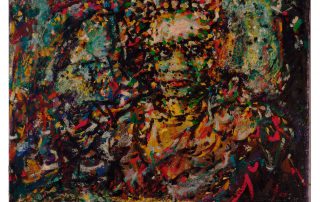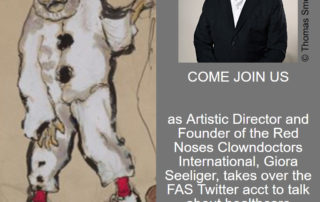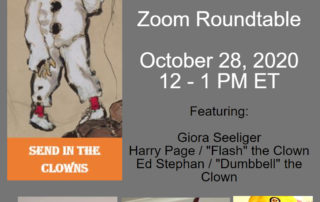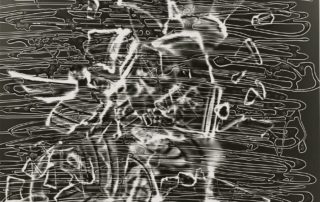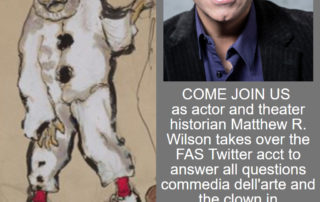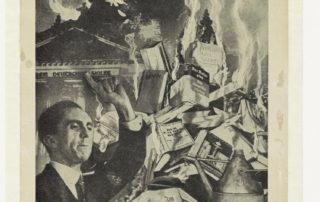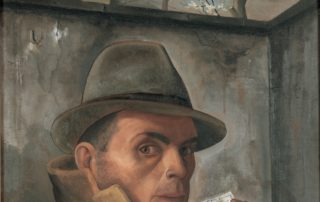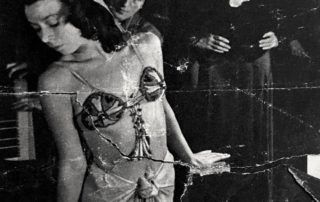Rachel Stern2021-01-11T06:14:12-05:00December 2nd, 2020|Events, Lectures, Past Events|
WATCH THE RECORDING OF THIS EVENT HERE. More information about Janice Biala is available HERE. Lecture featuring Jason Andrew Independent Scholar, Curator and Producer in New York Introduced by Rachel Stern Executive Director of the Fritz Ascher Society in New York Biala (1903-2000) was a Polish born American painter whose career stretched over eight decades and spanned two continents. Through it all, she retained an intimacy in her art rooted in Old World Europe—sensibilities that began with memories of her childhood in a Polish village, shaped by School of Paris painters like Bonnard, Matisse and Braque, inspired by Velázquez and the Spanish Masters, and broadened by the community of loft-living artists in Post World War II Downtown New York. Her [...]
Elizabeth Berkowitz2024-03-05T08:12:14-05:00November 18th, 2020|Exhibitions|
This digital exhibition includes important examples from the oeuvre of the German Jewish Expressionist artist Fritz Ascher (1893-1970). Ascher’s career extended from prior to the First World War until the late 1960s. However, Ascher’s artistic trajectory was interrupted due to persecution under National Socialism, and he spent much of the Second World War in hiding, concealed in a family friend’s basement. Ascher’s work consequently encompasses both the vibrant artistic scene in early-20th-century Germany, as well as the trauma and aesthetic shifts consequent of Ascher’s persecution and deprivations during the twelve years of the Nazi regime. These selected works are representative not only of critical moments in Ascher’s personal and artistic development, but also of key themes that occupied Ascher’s [...]
Rachel Stern2020-11-02T20:09:58-05:00September 30th, 2020|Events, Past Events, Send in the Clowns|
Twitter @Ascher_Society Giora Seeliger, Artistic Director and Founder of Red Noses Clowndoctors International, takes over the FAS Twitter account to answer your burning questions about clowning, the role of a healthcare clown, and anything else that comes to mind! Submit your questions in advance by writing to info@fritzaschersociety.org Part of "Send in the Clowns," an interactive two-week digital initiative, which explores the clown as a figure between tragedy and comedy, between self- identification and stage--a character designed to (literally) mask the performer’s true feelings behind a facade of happiness. “Send in the Clowns” uses the prominence of the “clown” figure in Fritz Ascher’s work as a lens through which to explore the duality of the clown both historically and today. [...]
Rachel Stern2020-10-28T14:24:47-04:00September 30th, 2020|Events, Past Events, Send in the Clowns|
Watch the recording of this event HERE. Roundtable featuring Giora Seeliger Artistic Director and Founder of the Red Noses Clowndoctors International Harry Page “Flash” the Clown Ed Stephan “Dumbbell” the Clown Moderated by Elizabeth Berkowitz Art Historian and Digital Interpretation Manager, The Fritz Ascher Society in New York One of the more appealing aspects of the clown subject to artists like Fritz Ascher was the divide between a public persona committed to joy and happiness, and the pain or sadness that might lurk beneath the real, human surface. Hospital or healthcare clowns straddle this divide every day of their professional lives—working to bring happiness to child patients who are often in circumstances that might otherwise inspire grief or pain. This [...]
Rachel Stern2022-03-06T11:39:32-05:00September 30th, 2020|Events, Lectures, Past Events|
Lecture by Lynette Roth Daimler Curator of the Busch-Reisinger Museum and Head of the Division of Modern and Contemporary Art at the Harvard Art Museums Moderated by Rachel Stern Executive Director of the Fritz Ascher Society in New York Anneliese Hager (1904-1997) is one of a number of modern artists who began their artistic experimentation in Germany after National Socialist cultural policy began to harden against all forms of modern art. Her preferred medium was the photogram, a photographic image made by placing an object directly on (or in close proximity to) a light-sensitive surface and exposing it to light. Hager called the reversal of light and dark in the resulting contact print “white shadows.” [...]
Rachel Stern2020-09-29T20:08:44-04:00September 29th, 2020|Events, Send in the Clowns|
Twitter @Ascher_Society Actor and theater historian Matthew R. Wilson takes over the FAS Twitter account to discuss the history of the Commedia dell’Arte, key themes in the genre, and how the Commedia dell’Arte has impacted popular culture. Submit your questions in advance by writing to info@fritzaschersociety.org Part of "Send in the Clowns," an interactive two-week digital initiative, which explores the clown as a figure between tragedy and comedy, between self- identification and stage--a character designed to (literally) mask the performer’s true feelings behind a facade of happiness. “Send in the Clowns” uses the prominence of the “clown” figure in Fritz Ascher’s work as a lens through which to explore the duality of the clown both historically and today. Generously sponsored [...]
Rachel Stern2020-10-22T00:35:30-04:00September 29th, 2020|Events, Past Events, Send in the Clowns|
Watch the recording of this event HERE. Roundtable featuring Matthew R. Wilson Director (SDC), Actor (AEA, SAG-AFTRA), and Fight Director (SAFD, SDC), as well as a scholar and playwright Ori Z. Soltes Teaching Professor at Center for Jewish Civilization, Georgetown University, Washington D.C. Tricia Manuel / "Pricilla Mooseburger" the Clown Tricia Manuel is the unmistakable Pricilla Mooseburger! Moderated by Elizabeth Berkowitz Art Historian and Digital Interpretation Manager, The Fritz Ascher Society in New York How do we define “the clown,” historically, in art, and today, in practice? What is the appeal of the clown in performance, and how has the clown subject impacted popular culture? This roundtable pools the expertise from a diversity of fields to place Fritz Ascher’s interest in “the [...]
Rachel Stern2020-11-04T15:01:37-05:00September 17th, 2020|Events, Lectures, Past Events|
WATCH THE RECORDING OF THIS EVENT HERE. Lecture featuring Rosa von der Schulenburg, Head of the Art Collection of the Academy of Arts in Berlin Moderated by Rachel Stern, Executive Director of the Fritz Ascher Society in New York John Heartfield (1891-1968) was a German visual artist who pioneered the use of art as a political weapon. This presentation starts with preliminary remarks about John Heartfield’s bequest in the Akademie der Künste in Berlin and shows how it is accessible nowadays. A short introduction of how all began follows, showing the background of the birth of Heartfield’s political photo-montages (World War I, Dada, Communist Party, Willi Münzenberg’s Die Arbeiter-Illustrierte-Zeitung in short AIZ), glances at Heartfield’s first exile stage in Prague and then focuses on [...]
Elizabeth Berkowitz2020-10-07T15:08:59-04:00September 16th, 2020|Lectures|
WATCH THE RECORDING OF THIS EVENT HERE. Lecture featuring Anne Sibylle Schwetter, Curator of the Felix Nussbaum Collection in the Felix Nussbaum House in the Osnabrück Museum Quarter, Osnabrück Moderated by Rachel Stern, Executive Director of the Fritz Ascher Society in New York The German-Jewish artist Felix Nussbaum (1904 Osnabrück - 1944 Auschwitz) started a promising career in Berlin around 1930, which ended abruptly when the National Socialists came to power in 1933. Years in exile in Italy and Belgium followed. In 1942 Nussbaum went into hiding in Brussels. The artist's last paintings were created here from June 1943 until shortly before his arrest in June 1944. A little later he was murdered in Auschwitz. Like hardly any other painter [...]
Elizabeth Berkowitz2020-09-16T19:55:58-04:00September 16th, 2020|Lectures|
View a recording of this event HERE. EXCLUSIVE: Watch Annette von Wangenheim's German language documentary film "Tanz unterm Hakenkreuz" from 2003 HERE. Big thanks to Annette von Wangenheim and Sabine Rollberg for making this possible! Gyp Schlicht speaks at 38:02 min. Lecture featuring Sabine Rollberg, Professor Emeritus of Documentary Film at the Academy of Media Arts in Cologne and former ARTE Representative and ARTE Commissioning Editor for WDR Moderated by Rachel Stern, Executive Director of the Fritz Ascher Society in New York In times of Nazi Germany, becoming an artist was not the typical career path for women. The „deutsche Frau“ was supposed to represent the “good housewife”, as a mother of many children, not wearing make-up and fancy dresses. The Nazis were refuting [...]
Rachel Stern2020-10-07T15:06:33-04:00August 31st, 2020|Events, Past Events|
WATCH THE RECORDING OF THIS EVENT HERE. Lecture featuring Anne Sibylle Schwetter, Curator of the Felix Nussbaum Collection in the Felix Nussbaum House in the Osnabrück Museum Quarter, Osnabrück Moderated by Rachel Stern, Executive Director of the Fritz Ascher Society in New York The German-Jewish artist Felix Nussbaum (1904 Osnabrück - 1944 Auschwitz) started a promising career in Berlin around 1930, which ended abruptly when the National Socialists came to power in 1933. Years in exile in Italy and Belgium followed. In 1942 Nussbaum went into hiding in Brussels. The artist's last paintings were created here from June 1943 until shortly before his arrest in June 1944. A little later he was murdered in Auschwitz. Like hardly any other painter [...]
Rachel Stern2020-09-25T07:28:27-04:00August 19th, 2020|Events, Lectures, Past Events|
View a recording this event HERE EXCLUSIVE: Watch Annette von Wangenheim's German language documentary film "Tanz unterm Hakenkreuz" from 2003 HERE. Big thanks to Annette von Wangenheim and Sabine Rollberg for making this possible! Gyp Schlicht speaks at 38:02 min. Lecture featuring Sabine Rollberg, Professor Emeritus of Documentary Film at the Academy of Media Arts in Cologne and former ARTE Representative and ARTE Commissioning Editor for WDR Moderated by Rachel Stern, Executive Director of the Fritz Ascher Society in New York In times of Nazi Germany, becoming an artist was not the typical career path for women. The „deutsche Frau“ was supposed to represent the “good housewife”, as a mother of many children, not wearing make-up and fancy dresses. The Nazis were refuting what [...]



